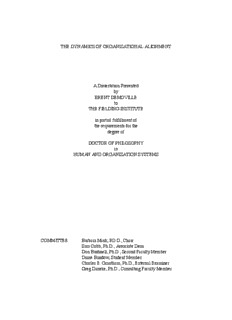
THE DYNAMICS OF ORGANIZATIONAL ALIGNMENT A Dissertation PDF
Preview THE DYNAMICS OF ORGANIZATIONAL ALIGNMENT A Dissertation
THE DYNAMICS OF ORGANIZATIONAL ALIGNMENT A Dissertation Presented by BRENT DEMOVILLE to THE FIELDING INSTITUTE in partial fulfillment of the requirements for the degree of DOCTOR OF PHILOSOPHY in HUMAN AND ORGANIZATION SYSTEMS COMMITTEE: Barbara Mink, ED.D., Chair Sara Cobb, Ph.D., Associate Dean Don Bushnell, Ph.D., Second Faculty Member Diane Bandow, Student Member Charles E. Grantham, Ph.D., External Examiner Greg Daneke, Ph.D., Consulting Faculty Member ii ABSTRACT.................................................................................................................VIII CHAPTER I: INTRODUCTION...................................................................................1 STATEMENT OF THE RESEARCH QUESTION.....................................................................1 SIGNIFICANCE OF THE PROBLEM.....................................................................................2 CHAPTER II: REVIEW OF THE LITERATURE......................................................5 DEFINITIONS...................................................................................................................5 Alignment as Commitment........................................................................................5 Alignment as Cultural Alignment..............................................................................5 Alignment as Shared Understanding........................................................................6 Alignment as Organizational Linkage......................................................................6 Alignment as Congruence.........................................................................................7 Alignment as Attunement..........................................................................................7 Alignment as Shared Understanding Expressed Congruently..................................8 MODELING......................................................................................................................8 Types of Systems Models...........................................................................................9 Causal Loop Models........................................................................................................12 Stock and Flow Models...................................................................................................13 The Generic Model of Alignment............................................................................14 Basic Systems Models.............................................................................................19 McKinsey’s 7-S Framework............................................................................................20 Leavitt’s Diamond...........................................................................................................21 The Business Diamond....................................................................................................22 iii OP Model.........................................................................................................................24 Organizational Congruence Model..................................................................................26 CHAOS AND STABILITY: A CONFOUNDING VARIABLE..................................................29 SYSTEM DYNAMICS......................................................................................................30 CHAPTER III: METHODOLOGY.............................................................................34 DESCRIPTION OF THE SYSTEM AND ITS COMPONENTS...................................................35 Inputs......................................................................................................................35 Environment....................................................................................................................35 Resources.........................................................................................................................36 History.............................................................................................................................36 Strategy...................................................................................................................36 Transformation Process..........................................................................................38 Informal Organization......................................................................................................38 Formal Organization........................................................................................................39 People..............................................................................................................................40 Work................................................................................................................................42 Critical Features...............................................................................................................43 Outputs....................................................................................................................44 Variable Value Ranges...........................................................................................45 MODEL VALIDATION....................................................................................................47 Structure Tests........................................................................................................48 Behavior Tests.........................................................................................................49 PROCEDURES................................................................................................................51 CHAPTER IV: THE MODEL......................................................................................53 INPUTS..........................................................................................................................54 iv Turbulence..............................................................................................................54 Resources................................................................................................................55 STRATEGY....................................................................................................................56 Realization of Emergent Strategy...........................................................................58 Planned Objectives.................................................................................................59 Clear Communications...........................................................................................59 Work........................................................................................................................60 WORK SUB-SYSTEMS...................................................................................................62 Work Factor............................................................................................................62 Performance Factor................................................................................................63 Skill Gap.................................................................................................................64 Skill Change............................................................................................................64 Skill Development...................................................................................................66 Accomplishment......................................................................................................67 Intrinsic Reward.....................................................................................................68 Routineness.............................................................................................................69 PEOPLE.........................................................................................................................70 Personal Needs.......................................................................................................71 Role Clarity.............................................................................................................71 Role Clarity.............................................................................................................72 Intra-group Relations.............................................................................................72 Inter-group Relations..............................................................................................73 Group Impact..........................................................................................................73 Activity grouping.....................................................................................................74 v FORMAL ORGANIZATION..............................................................................................75 Centralized Control................................................................................................77 Reward Congruence...............................................................................................77 INFORMAL ORGANIZATION...........................................................................................78 Organizational Climate..........................................................................................78 BEHAVIOR OF THE MODEL............................................................................................79 The Perfect Organization........................................................................................79 The Leadership Challenged Organization..............................................................81 Communication as a Challenge..............................................................................83 Low Trust Organization..........................................................................................85 Change, Turbulence, and Chaos.............................................................................87 FEEDBACK FROM EXTERNAL REVIEW...........................................................................90 Match to Experience...............................................................................................91 General Comments..................................................................................................92 Thoughts Regarding the Interaction of Model Elements........................................94 MODEL VALIDATION..................................................................................................101 Model Structure....................................................................................................101 Model Behavior.....................................................................................................102 Summary of Model Validity..................................................................................103 CHAPTER V: DISCUSSION.....................................................................................105 NADLER AND TUSHMAN’S MODEL.............................................................................106 Inputs....................................................................................................................106 Work......................................................................................................................110 People...................................................................................................................111 vi Personal Needs..............................................................................................................111 Role Clarity....................................................................................................................112 Intra-group Relationships..............................................................................................112 Inter-group Relationships..............................................................................................113 Impact of Leadership.....................................................................................................114 Formal Organization............................................................................................115 Structure........................................................................................................................115 Reward Systems.............................................................................................................116 Informal Organization..........................................................................................117 Politics and Trust...........................................................................................................117 Communications...................................................................................................118 Output...................................................................................................................119 APPLICATION OF THE MODEL......................................................................................120 SUGGESTIONS FOR FUTURE RESEARCH.......................................................................124 CONCLUSIONS............................................................................................................125 REFERENCES.............................................................................................................128 APPENDIX A...............................................................................................................134 EVALUATION SHEETS.................................................................................................134 APPENDIX B................................................................................................................138 INTRODUCTION TO THE MODEL’S FLIGHT SIMULATOR...............................................138 APPENDIX C...............................................................................................................154 EXPERT REVIEWERS AND QUALIFICATIONS................................................................154 APPENDIX D...............................................................................................................155 vii EVALUATOR REVIEW FORMS......................................................................................155 APPENDIX E................................................................................................................170 THE MODEL................................................................................................................170 APPENDIX F................................................................................................................171 THE EQUATIONS.........................................................................................................171 viii ABSTRACT Organizations are challenged to meet their mission and the failure to achieve this objective is a source of concern for organizations. Models exist that explore the components that contribute to organizational success, but these models are conceptual and do not attempt to operationally define the relationships depicted in the models. Nadler and Tushman (1992) created a model of Organizational Congruence that serves as the foundation for this dissertation. The author translated that model into a systems dynamic model that mathematically defines the potential relationships of the components in Nadler and Tushman’s model. The system dynamics model is an “Executive Flight Simulator” with the capability of running simulations to see the impact of changing the values of the different components. A panel of experts, representing industry and organizational consultants, validated the model against their experience in the world and confirmed that the model matched their experience. The model provides a strong start toward understanding the physics of alignment in organizations. It explores the impact of key variables such as Communication, Leadership, and Turbulence on the realization of planned and emergent strategies within an organization. The model suggests that in highly turbulent environments, organizations need to be able to adapt and shift their focus from ix planned objectives to the newly emergent objectives that result from the dynamically changing environment. 1 CHAPTER I: INTRODUCTION Statement of the Research Question Each year organizations devote their energies toward fulfilling the mission and vision of the organization, yet their results do not always meet their expectations. These less than satisfactory results are achieved in spite of the best efforts of the people combined with the significant application of material and financial resources. Burton and Moran (1995) suggest that the problem may be related to organizational alignment. To be profitable to both [customer and organization] requires the providing organization to focus its resources in the most productive manner possible. This focusing process requires an alignment of the business plan, quality plan, strategic plan, research and development plan, and so on. Alignment requires that a leading purpose be established to which all the work of an organization is aligned and designed to achieve. The problem today is that every organization has so many plans that they compete with one another for the limited resources available. (p. 15) Each part of the organization is working to achieve its individual mission, but due to the lack of clear alignment the total result is sub-optimized. The immediate solution might appear to be a better planning process that aligned all of the sub- plans, but as Mintzberg (1994) observed, the planning process has a number of pitfalls. Alignment must be viewed as part of the larger organizational system. That system has its own structure, logic, and dynamic. That is, it has its own physics. In order to better organize and align an organization, it will be necessary to understand its underlying physics.
Description: